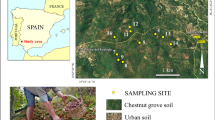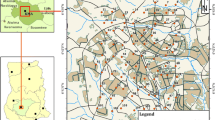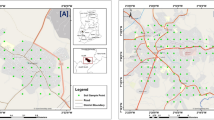Abstract
Elemental concentrations and bioaccessibility were determined in background soils collected in Canada as part of the North American Geochemical Landscapes Project. The concentrations of As, Cr, Cu, Co, Ni and Zn were higher in the C-horizon (parent material) compared to 0–5 cm (surface soil), and this observation along with the regional distribution suggested that most of the variability in concentrations of these elements were governed by the bedrock characteristics. Unlike the above-stated elements, Pb and Cd concentrations were higher in the surface layer reflecting the potential effects of anthropogenic deposition. Elemental bioaccessibility was variable decreasing in the order Cd > Pb > Cu > Zn > Ni > Co > As > Cr for the surface soils. With the exception of As, bioaccessibility was generally higher in the C-horizon soils compared to the 0–5 cm soils. The differences in metal bioaccessibility between the 0–5 cm and the C-horizon and among the provinces may reflect geological processes and speciation. The mean, median or 95th percentile bioaccessibility for As, Cr, Cu, Co, Ni and Pb were all below 100 %, suggesting that the use of site-specific bioaccessibility results for these elements will yield more accurate estimation of the risk associated with oral bioavailability for sites where soil ingestion is the major contributor of human health risk.



Similar content being viewed by others
References
Basta, N., & Juhasz, A. (2014). Using in vivo bioavailability and/or in vitro gastrointestinal bioaccessibility testing to adjust human exposure to arsenic from soil ingestion. Reviews in Mineralogy and Geochemistry, 79, 451–472.
Bright, D. A., Richardson, G. M., & Dodd, M. (2006). Do current standards of practice measure what is relevant to human exposure at contaminated sites? I: A discussion of soil particle size and contaminant partitioning in soil. Human and Ecological Risk Assessment, 12, 591–605.
Bromstad, M. J. (2011). The characterization, persistence, and bioaccessibility of roaster-derived arsenic in surface soils at giant mine, yellowknife, NT. A thesis submitted to the Department of Geological Sciences and Geological Engineering in conformity with the requirements for the Degree of Master of Science, Queen’s University. November 2011.
Canadian Council of Ministers of the Environment (CCME). (1993). Guidance manual on sampling, analysis and data management for contaminated sites, volume I: Main report, CCME EPC-NCS62E (p. 2). Winnipeg, Manitoba.
Cave, M. R., Wragg, J., Denys, S., Jondreville, C., & Feidt, C. (2011). Oral bioavailability. In F. A. Swartjes (Ed.), Dealing with contaminated sites (pp. 287–324). New York: Springer.
CCME. (1999). Canadian environmental quality guidelines.
Drexler, J. W., & Brattin, W. J. (2007). An in vitro procedure for estimation of lead relative bioavailability: With validation. Human and Ecological Risk Assessment, 13, 383–401.
Federal Contaminated Sites Inventory. (2015). http://www.tbs-sct.gc.ca/fcsi-rscf/home-accueil-eng.aspx. Accessed 15 September 2015.
Friske, P. W. B., Ford, K. L., Kettles, I. M., McCurdy, M. W., McNeil, R. J., & Harvey, B. A. (2010). North American soil geochemical landscapes project: Canadian field protocols for collecting mineral soils and measuring soil gas radon and natural radioactivity. Geological Survey of Canada, Open File 6282; 177 p.
Girard, I., Klassen, R. A., & Laframboise, R. R. (2004). Sedimentology laboratory manual, Terrain Sciences Division. Geological Survey of Canada, Open File 4823.
Goodwin, T. A., Parker, L., Fisher, B. E. & Dummer, T. J. B. (2010). Mineral resources branch, report of activities 2009. Nova Scotia Department of Natural Resources, Report ME 2010-1, pp. 41–44.
Health Canada. (2009). Memorandum: Interim CSD guidance on a TRV for lead (Pb) and interpretation of Pb bioaccessibility data for federal contaminated site human health risk assessment in Canada. Contaminated Sites Division, Health Canada, Ottawa, ON Canada. Dated December 2009.
Health Canada. (2010). Federal contaminated site risk assessment in Canada, part V: Guidance on human health detailed quantitative risk assessment of chemicals (DQRA Chem ). Report H128-1/11-639E-PDF, Health Canada, Ottawa, ON, Canada.
Health Canada. (2012). Federal contaminated site risk assessment in Canada, part I: Guidance on human health preliminary quantitative risk assessment (PQRA), version 2.0. Report H128-1/11-632E-PDF, Health Canada, Ottawa, ON, Canada.
Jacques Whitford. (2006). Ingestion bioavailability of arsenic, lead and cadmium in human health risk assessments: Critical review, and recommendations. Submitted to Health Canada, Ottawa, ON. http://www.bioavailabilityresearch.ca/Health%20Canada%20Bioavailability.final.pdf. Accessed 15 September 2015.
Juhasz, A. L., Herde, P., Herde, C., Boland, J., & Smith, E. (2014). Validation of the predictive capabilities of the SBRC-G in vitro assay for estimating arsenic relative bioavailability in contaminated soils. Environmental Science and Technology, 48, 12962–12969.
Kabata-Pendias, A. (2011). Trace elements in soils and plants (4th ed.). Boca Raton: CRC Press.
Klassen, R. A., Douma, S. L., Ford, A., Rencz, A. & Grunsky, E. (2009). Geoscience modeling of relative variation in natural arsenic hazard in potential in New Brunswick. Geological Survey of Canada, Current Research 2006–7.
Ljung, K., Oomen, A., Duits, M., Selinus, O., & Berglund, M. (2007). Bioaccessibility of metals in urban playground soils. Journal of Environmental Science and Health, Part A: Toxic/Hazardous Substances and Environmental Engineering, 42(9), 1241–1250. doi:10.1080/10934520701435684.
McKeague, J. A., & Wolynetz, M. S. (1980). Background levels of minor elements in some Canadian soils. Geoderma, 24, 299–307.
Meunier, L., Walker, S. R., Wragg, J., Parsons, M. B., Koch, I., Jamieson, H. E., & Reimer, K. J. (2010). Effects of soil composition and mineralogy on the bioaccessibility of arsenic from tailings and soil in gold mine districts of Nova Scotia. Environmental Science and Technology, 44(7), 2667–2674.
Morman, S. A., Plumlee, G. S., & Smith, D. B. (2009). Application of in vitro extraction studies to evaluate element bioaccessibility in soils from a transect across the United States and Canada. Applied Geochemistry, 24, 1454–1463.
Ollson, C. A. (2003). Arsenic risk assessments: The importance of bioavailability. Ph.D. thesis, Faculty of Chemistry and Chemical Engineering, Royal Military College of Canada, Kingston, ON. 377 p.
Rencz, A., Garrett, R. G., Adcock S. W. & Bonham-Carter G. F. (2006). Geochemical background in soil and till. Geological Survey of Canada, Open File 5084. Natural Resources Canada, Ottawa, ON.
Rencz, A., Garret, R. G., Kettle, I. M., Grunsky, E. C., & McNeil, R. J. (2011). Using soil geochemical data to estimate the range of background element concentrations for ecological and human health risk assessments. Geological Survey of Canada, Current Research. doi:10.4095/288746.
Richardson, G. M. (2002). Determining natural (background) arsenic soil concentrations in Yellowknife NWT, and deriving site-specific human health-based remediation objectives for arsenic in the Yellowknife area. Final report, submitted by Risklogic Scientific Services Inc. to the Yellowknife Arsenic Soils Remediation Committee (YASRC), Yellowknife, April 2002.
Richardson, G. M., Bright, D. A., & Dodd, M. (2006). Do current standards of practice measure what is relevant to human exposure at contaminated sites? II. Oral bioaccessibility of contaminants in soil. Human and Ecological Risk Assessment, 12, 606–616.
Richardson, G. M., & Fast, A. (2014). Bioaccessibility and bioavailability: The great opportunity not realized (so far). Presented at the 35th Annual Meeting of SETAC North America, Vancouver, BC, 11 November 2014.
Ruby, M. V. (2004). Bioavailability of soil-borne chemicals: Abiotic assessment tools. Human and Ecological Risk Assessment, 10, 647–656.
Smith, D. B., Woodruff, L. G., O’Leary, R. M., Cannon, W. F., Garrett, R. G., Kilburn, J. E., & Goldhaber, M. B. (2009). Pilot studies for the North American Soil Geochemical Landscapes Project—Site selection, sampling protocols, analytical methods, and quality control protocols. Applied Geochemistry, 24, 1357–1368.
Turner, A., & Simmonds, L. (2006). Elemental concentrations and metal bioaccessibility in UK Household dust. Science of the Total Environment, 371, 74–81.
USEPA. (1994). Method 200.8 determination of trace elements in waters and wastes by inductively coupled plasma-mass spectrometry, Revision 5.4. https://www.epa.gov/sites/production/files/2015-06/documents/epa-200.8.pdf.
USEPA. (1996). Method 3050B acid digestion of sediments, sludges, and soils. EPA SW-846, test methods for evaluating solid waste, physical/chemical methods.
USEPA. (2007a). Guidance for evaluating the oral bioavailability of metals in soils for use in human health risk assessment. May 2007, OSWER 9285.7-80. Office of Solid Waste and Remedial Response, Washington, DC, USA.
USEPA. (2007b). Estimation of relative bioavailability of lead in soil and soil-like materials using in vivo and in vitro methods. Office of Solid Waste and Emergency Response 9285.7-77. http://www.epa.gov/superfund/health/contaminants/bioavailability/guidance.htm. Accessed 15 September 2015.
USEPA. (2012). Standard operating procedure for an in vitro bioaccessibility assay for lead in soil, EPA 9200.2-86.
USEPA. (2013). Statistical Software ProUCL 5.0.00 for Environmental Applications for Data Sets with and without Nondetect Observations. http://www.epa.gov/osp/hstl/tsc/software.htm. Accessed 15 September 2015.
Wang, S., & Mulligan, C. N. (2006). Occurrence of arsenic contamination in Canada: Sources, behavior and distribution. Science of the Total Environment, 366(2–3), 701–721.
Acknowledgments
The authors thank Health Canada’s Contaminated Sites Division and the Federal Contaminated Sites Action Plan (FCSAP) for funding. We also thank D. Lee for her review and valuable comments.
Author information
Authors and Affiliations
Corresponding author
Electronic supplementary material
Below is the link to the electronic supplementary material.
Rights and permissions
About this article
Cite this article
Dodd, M., Richardson, G.M., Wilson, R. et al. Elemental concentrations and in vitro bioaccessibility in Canadian background soils. Environ Geochem Health 39, 759–777 (2017). https://doi.org/10.1007/s10653-016-9846-9
Received:
Accepted:
Published:
Issue Date:
DOI: https://doi.org/10.1007/s10653-016-9846-9




